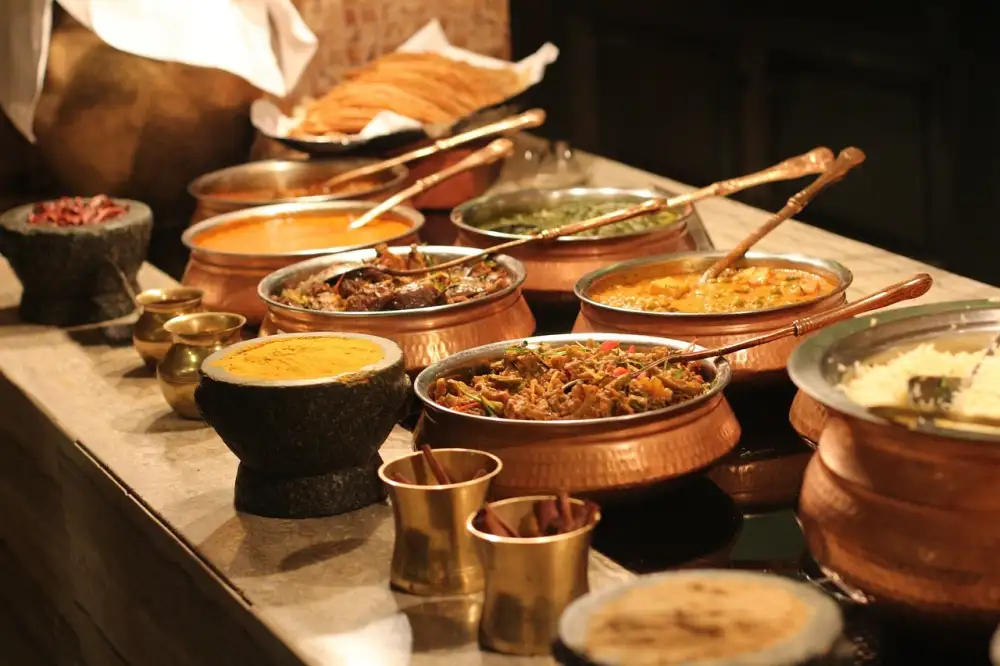Spice Up Your Cooking: Essential Indian Spices to Elevate Your Recipes

Indian spices are the heart and soul of Indian cuisine, renowned for their vibrant colors, rich flavors, and aromatic profiles. With a history dating back thousands of years, these spices have not only been used to enhance the taste of dishes but also for their medicinal properties. From the warm earthiness of turmeric to the fragrant sweetness of cardamom, each spice brings its own unique essence to traditional Indian cooking. Join us on a journey through the diverse world of Indian spices as we explore their flavors, health benefits, and tips for incorporating them into your culinary creations.
Common Indian Spices Used in Cooking:
2. Common Indian Spices Used in Cooking:
Indian cuisine is renowned for its vibrant and aromatic flavors, largely due to the use of a variety of spices. Some common Indian spices that are essential in elevating dishes include:
2.1. Turmeric: Known for its vibrant yellow color and earthy flavor, turmeric adds depth to curries and rice dishes.
2.2. Cumin: Cumin seeds or powder are often used to add a warm and nutty flavor to dishes like dals (lentil soups) and vegetable stir-fries.
2.3. Coriander: Both the seeds and leaves of coriander are used in Indian cooking, imparting a fresh citrusy note to curries and chutneys.
2.4. Cardamom: This fragrant spice is commonly used in desserts, chai tea, and savory dishes like biryanis for its unique floral aroma.
2.5. Cloves: With their strong, sweet, and slightly bitter taste, cloves are often used in rice dishes, meat marinades, and spiced drinks.
2.6. Cinnamon: Cinnamon sticks or powder lend a warm sweetness to both sweet and savory dishes such as kormas (creamy curries) and desserts.
2.7. Mustard Seeds: These tiny seeds are tempered in hot oil at the start of many Indian recipes to release their nutty flavor before adding other ingredients.
2.8. Fenugreek: Often used as dried leaves or seeds, fenugreek imparts a slightly bitter taste that enhances the flavor of vegetable dishes and lentil stews.
2.9. Asafoetida: Also known as "hing," this pungent spice is used sparingly to add an umami depth to vegetarian dishes like dals and sabzis (vegetable stir-fries).
2.10 Red Chili Powder: Made from dried red chilies, this spice adds heat and color to various Indian dishes such as curries, snacks, and pickles.
1. Turmeric
**2.1 Turmeric**
Turmeric, known for its vibrant yellow color, is a staple in Indian cuisine and traditional medicine. It contains curcumin, a compound with powerful anti-inflammatory and antioxidant properties. Turmeric is commonly used in curries, rice dishes, and lentil soups to add flavor and color. Its earthy taste pairs well with other spices like cumin and coriander. Additionally, turmeric has been linked to potential health benefits such as improved digestion, reduced inflammation, and enhanced immune function.
2. Cumin
**2.2. Cumin**
Cumin, with its warm and earthy flavor, is a staple in Indian cuisine. This spice is known for its aromatic properties and adds a depth of flavor to dishes. Rich in iron and antioxidants, cumin also offers digestive benefits and may help improve blood sugar control. Toasting cumin seeds before grinding them can enhance their flavor profile. Whether used whole or ground, cumin is versatile and can be added to curries, rice dishes, soups, and even marinades for meats.
3. Coriander
**2.3. Coriander**
Coriander, also known as cilantro or dhania, is a versatile herb used both fresh and dried in Indian cuisine. The seeds are commonly ground into a powder to add flavor to dishes. Coriander is rich in antioxidants, vitamins A, C, and K, and minerals like calcium and potassium. It aids digestion, reduces inflammation, and may help lower blood sugar levels. Its citrusy and slightly sweet flavor enhances curries, chutneys, and marinades, making it a staple in Indian cooking for its aromatic touch and health benefits.
4. Cardamom
**4. Cardamom**
Cardamom, often referred to as the "Queen of Spices," is a highly prized spice in Indian cuisine known for its unique flavor profile that combines floral, citrusy, and spicy notes. It is available in two varieties: green cardamom and black cardamom. Green cardamom is more commonly used in sweet dishes and desserts, while black cardamom has a smokier flavor and is typically used in savory dishes.
This aromatic spice not only adds depth to dishes but also offers various health benefits. Cardamom contains essential oils that have antioxidant properties, aiding in digestion and promoting gut health. It also has antibacterial effects and may help lower blood pressure and improve breathing by dilating airways.
When using cardamom in cooking, it's best to crush the pods slightly before adding them to release their flavorful seeds. Ground cardamom can lose its potency quickly, so it's recommended to buy whole pods and grind them as needed for the freshest taste.
Incorporating cardamom into your recipes can elevate both sweet and savory dishes, from curries and rice pilafs to cakes and cookies. Experimenting with this versatile spice can add a touch of sophistication to your culinary creations while reaping its numerous health benefits.
5. Cloves
Cloves are a versatile spice commonly used in Indian cooking for their warm, sweet, and aromatic flavor profile. They are rich in antioxidants and have anti-inflammatory properties that can help improve digestion and boost immunity. Cloves also contain important minerals like manganese, vitamin K, and dietary fiber. When using cloves in your recipes, it's best to use them whole or ground sparingly as they have a strong flavor. Incorporate cloves into savory dishes like biryanis or curries, or add them to desserts like rice pudding or spiced cakes for a unique depth of flavor.
6. Cinnamon
**6. Cinnamon**
Cinnamon, a versatile spice commonly used in Indian cuisine, adds warmth and sweetness to dishes. It is derived from the inner bark of trees belonging to the genus Cinnamomum. This fragrant spice is rich in antioxidants and has anti-inflammatory properties that may help lower blood sugar levels and reduce the risk of heart disease. In cooking, cinnamon is often used in curries, rice dishes, desserts like kheer (rice pudding), and beverages such as chai tea. Its distinct flavor profile can enhance both savory and sweet recipes, making it a must-have spice in your pantry for adding depth and complexity to your dishes.
7. Mustard Seeds
Mustard seeds are a staple in Indian cooking, adding a unique flavor and aroma to dishes. They come in three varieties: black, brown, and white. Black mustard seeds have a stronger taste, while white seeds are milder. Mustard seeds are rich in antioxidants and minerals like iron, calcium, zinc, and magnesium. They also contain essential oils that have antibacterial properties. To enhance their flavor, it's common to heat them in oil until they pop before adding other ingredients to the dish.
8. Fenugreek
**2.8 Fenugreek**
Fenugreek, with its distinctive sweet and nutty flavor, is a common spice used in Indian cooking. Not only does it add depth to dishes, but it also offers various health benefits. Fenugreek seeds are rich in fiber, iron, and magnesium, making them beneficial for digestion and heart health. Additionally, fenugreek is known for its potential to help regulate blood sugar levels and reduce inflammation in the body. When using fenugreek in your recipes, remember that a little goes a long way due to its potent flavor profile.
9. Asafoetida
**2.9. Asafoetida**
Asafoetida, also known as hing, is a pungent spice commonly used in Indian cuisine. It is derived from the resin of the Ferula plant and has a strong odor when raw but adds a savory umami flavor when cooked. Asafoetida is often used in vegetarian dishes to mimic the taste of onion and garlic, making it a popular alternative for those who avoid these ingredients. Additionally, it aids in digestion and is believed to have anti-inflammatory properties, making it a valuable addition to your spice collection for both flavor and health benefits.
10. Red Chili Powder
**2.10. Red Chili Powder**
Red chili powder, derived from dried red chilies, adds a fiery kick to Indian dishes. It contains capsaicin, which not only provides the heat but also offers health benefits like boosting metabolism and aiding digestion. Additionally, red chili powder is rich in antioxidants, vitamins A and C, and minerals like potassium and iron. When using red chili powder in your cooking, start with small amounts and adjust to taste to avoid overwhelming spiciness.
Health Benefits of Indian Spices
**Health Benefits of Indian Spices**
Indian spices not only add flavor and aroma to dishes but also offer a plethora of health benefits. Turmeric, known for its active compound curcumin, has powerful anti-inflammatory and antioxidant properties. Cumin aids digestion and may help improve blood sugar control. Coriander is rich in antioxidants and may promote heart health. Cardamom can help with digestive issues and may lower blood pressure. Cloves have antimicrobial properties and are high in antioxidants. Cinnamon may help lower blood sugar levels and reduce inflammation. Mustard seeds are a good source of omega-3 fatty acids and can aid in digestion. Fenugreek may help regulate blood sugar levels and reduce cholesterol. Asafoetida aids digestion and has anti-inflammatory properties. Red chili powder contains capsaicin, which may boost metabolism and reduce appetite. Incorporating these Indian spices into your cooking not only enhances the taste of your dishes but also provides a range of health benefits to support overall well-being.
Tips for Using Indian Spices in Cooking
When using Indian spices in cooking, it's essential to remember a few tips to make the most of their flavors. Firstly, toast whole spices before grinding them to enhance their aroma. Store spices in airtight containers away from heat and sunlight to preserve their potency. Experiment with different spice combinations to create unique flavors in your dishes. Lastly, start with small amounts of spices and adjust according to taste as you can always add more but cannot remove excess seasoning.
In conclusion, incorporating Indian spices into your cooking not only adds incredible flavors but also brings a wealth of health benefits. From turmeric's anti-inflammatory properties to cumin's digestion-aiding qualities, these spices have been used for centuries in traditional Indian medicine. By familiarizing yourself with these essential Indian spices and experimenting with them in your recipes, you can elevate the taste and nutritional value of your dishes. So, spice up your cooking and explore the vibrant world of Indian cuisine!
Published: 06. 04. 2024
Category: Recipes



